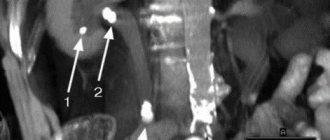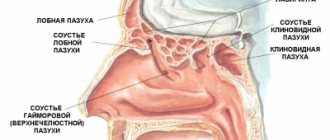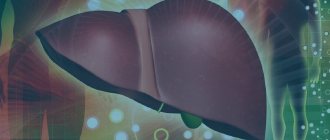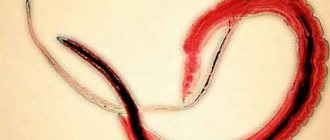Primary biliary cirrhosis is a destructive and inflammatory liver disease characterized by a chronic course. It is accompanied by damage to the intrahepatic ducts. As such cirrhosis progresses, ductopenia (disappearing bile duct syndrome) and persistent cholestasis (decreased bile flow into the duodenum due to disturbances in its production, excretion and/or excretion) may develop. In the terminal stage of the disease, liver failure is usually observed.
Symptoms
At an early stage, primary biliary cirrhosis may be asymptomatic or masked as manifestations of other diseases. As liver damage progresses, the following symptoms may occur.
Clinical signs
- Skin itching
. At first it occurs from time to time, then it becomes constant, often intensifying at night, which significantly reduces the quality of life. Patients may experience scratching on the skin of the arms, thighs, and back. Itching may be the only sign of primary biliary cirrhosis until cholestatic jaundice appears. Sometimes the symptom persists for many years. - Jaundice
. Typically occurs 6–24 months after the onset of itchy skin. There is yellowing of the skin, enlargement of the liver and spleen, acholic (light) stools, darkening of the urine (with a positive reaction to bilirubin). - Other symptoms
. Primary biliary cirrhosis may be accompanied by pain in the right hypochondrium, muscles and joints, fever, and the appearance of skin xanthelasmas (cholesterol deposits) in the palms, elbows, eyelids, and buttocks.
Laboratory signs
. With this cirrhosis, characteristic biochemical abnormalities are observed: increased bilirubin, alkaline phosphatase, ALT and AST transaminases, gamma-glutamyl transpeptidase (GGTP). In addition, lipid profiles change in patients. In many cases, when studying humoral immunity, an increased level of immunoglobulin class M is revealed. An increase in ESR and moderate anemia are also often detected.
Alcoholic cirrhosis of the liver
The disease is triggered by regular alcohol consumption. The usual “100 grams” every day after work may well lead to the development of the disease. The body suffers especially if the patient eats abnormally. A small amount of food or accompanying consumption of harmful food significantly increases the risks.
Liver cirrhosis: stages and symptoms in alcoholic form
At the initial stage, the pathology does not make itself felt and develops hidden. However, hardware studies reveal increased sizes of the organ.
This type of disease is characterized by reproductive dysfunction: women experience spontaneous abortions, men experience impotence and testicular atrophy. The same disorders include hormonal imbalances in the body.
How does the alcoholic form of the disease manifest:
- bowel dysfunction;
- loss of appetite;
- regular attacks of nausea and vomiting;
- loss of sensation in the limbs;
- muscle tissue becomes thinner.
Among the subtle symptoms are protein and vitamin deficiency in the body.
Complications
Intrahepatic cholestasis in primary biliary cirrhosis can cause a lack of bile in the intestine, which can be accompanied by steatorrhea (an increase in the amount of fatty components in the stool), the development of a deficiency of fat-soluble vitamins, impaired bone mineralization and, as a consequence, the occurrence of osteoporosis. As liver disease progresses, patients gradually lose weight and usually develop symptoms such as blurred vision, bone pain, bleeding gums, and possible pathological fractures.
general description
Biliary cirrhosis is
a chronic autoimmune disease that occurs as a result of a violation of the outflow of bile through the intrahepatic and biliary tract (cholestasis) and is characterized by the replacement of parenchymal liver tissue with connective tissue (fibrosis). The prognosis of the disease itself depends on diagnosis and in undiagnosed cases leads to deterioration of development: progressive destruction of the parenchyma with the formation of foci of fibrosis, which results in liver cirrhosis and liver failure.
According to statistics, in economically developed countries, biliary cirrhosis is diagnosed in people aged 30 to 55 years, more often in men. The ratio of incidence among men to women is approximately 3 to 1.
Treatment
Pathogenetic therapy
. This treatment is prescribed to stop the progression of primary biliary cirrhosis, improve the patient’s quality of life and increase its duration. As part of pathogenetic therapy, ursodeoxycholic acid preparations, which have anticholestatic, cytoprotective, immunomodulatory and hypocholesterolemic effects, can be used. The drug Phosphogliv®1 can be used as part of complex therapy for cirrhosis.
Use of corticosteroids
. To achieve regression of the clinical symptoms of the disease, corticosteroid hormones (prednisolone or its analogues) can be prescribed. The use of such drugs can improve biochemical and histological parameters and increase life expectancy.
Symptomatic therapy
. To reduce skin itching, sorbents and agents are usually prescribed that can reduce the flow of bile acids into the enterohepatic circulation. For steatorrhea and bile deficiency in the intestines, enzyme preparations with high levels of lipase can be used. If the patient is experiencing severe bone pain, parenteral administration of calcium supplements may be indicated. They are also used to prevent and treat osteoporosis.
Surgery
. Liver transplantation may be prescribed if the level of serum bilirubin exceeds 150 µmol/l, there are signs of decompensation of the process (hepatic encephalopathy, repeated bleeding from the esophageal veins, etc.). Before the development of cirrhosis, surgical treatment can be used in connection with severe osteoporosis, intolerable skin itching, and a significant decrease in quality of life.
1 According to the instructions for medical use of the drug.
Causes:
Due to their occurrence, there are 2 types of biliary cirrhosis:
- Primary biliary cirrhosis of the liver
- Secondary biliary cirrhosis of the liver
Primary biliary cirrhosis - the mechanism of occurrence is that autoimmune inflammation occurs in the liver tissue itself. Antibodies are produced against liver cells (hepatocytes) and they are perceived by the human body as foreign. The process itself is joined by a protective system, in the form of lymphocytes, macrophages, mast cells, which produce biologically active substances and antibodies. All of them together destroy hepatocytes, cause disturbances in blood supply, metabolism and bile stagnation, leading to general destruction of the architectonics (structure) of the liver.
- Genetic predisposition
- People suffering from autoimmune diseases such as rheumatoid arthritis, systemic lupus erythematosus, thyrotoxicosis, scleroderma, polyarteritis nodosa, sarcoidosis
- It is known from scientific sources that about 15% of cases of the disease are caused by an infectious substrate such as the herpes virus, rubella, Epstein-Barr
Secondary biliary cirrhosis of the liver occurs due to blockage or narrowing of the lumen of the intrahepatic bile ducts.
- Developmental anomalies (congenital or acquired) of the bile ducts and gallbladder
- Cholelithiasis
- Narrowing or blockage of the biliary tract after surgery on the abdominal organs, benign tumors
- External compression of the biliary tract by an inflamed pancreas or tumor
Diagnostics
NEARMEDIC clinics perform thorough diagnostics. The disease is detected in the early stages, when the disease can be brought under control, tissue can be restored, and progression can be interrupted. The initial appointment is carried out by an experienced gastroenterologist. The doctor establishes the clinical picture.
What tests are taken:
- general blood test (detects an increased content of leukocytes, a decrease in hemoglobin, platelets);
- biochemical blood test shows alkaline phosphatase, increased levels of bilirubin, ALT, AST, decreased albumin, high levels of potassium, urea, sodium, creatinine.
Hardware diagnostics and treatment
In NEARMEDIC clinics, modern ultrasound examination devices allow you to assess the condition of the organ: check the enlargement (accurately determine the size), see changes in the size of the spleen, evaluate the shape of the internal organs.
A computed tomography scan is performed to carefully examine the condition of the ducts, vessels, and tissues for damage. If a disease is suspected, Doppler measurements are performed to evaluate the blood vessels, and the doctor also recommends an MRI.
The most informative method is a biopsy: it best shows changes and the extent of organ damage. They will allow you to choose the most effective treatment method. Often, a diet, avoidance of harmful foods and drinks, and taking medications are sufficient for this.
Choose the clinic correctly so as not to pay too much for your health.
Diet
Diet plays an important role in the treatment of biliary cirrhosis. With the development of this disease, the functioning of not only the liver, but also other internal organs fails. And in order to reduce the burden on them and prevent the development of complications, all patients, without exception, need to follow certain rules in their diet. Depending on the severity of the disease and its accompanying complications, patients are assigned to treatment table No. 5a or No. 10 (mainly used when ascites occurs).
Violation of nutritional rules in biliary cirrhosis of the liver shortens the patient’s life
The daily calorie intake should not exceed 2900 kcal. In this case, it is imperative to refuse:
- fatty and fried foods;
- alcoholic drinks;
- dairy products;
- honey;
- fatty fish and meat;
- seafood;
- nuts
The main part of the diet should be fresh vegetables and fruits. You need to eat food in small quantities, but often - about 5-6 times a day. The last meal should be 2-3 hours before bedtime.
Food should be consumed boiled. Some dishes can be steamed. It is not advisable to bake food in the oven even without using oil and spices. In this case, food should be eaten warm. If liver function is impaired, hot and cold foods and drinks should not be consumed. Fasting days are held once every 2 weeks, during which the patient must eat only fresh vegetables and fruits.
Vegetables and fruits provide the body with vitamins and minerals, maintaining its functionality at the proper level.
An important point is compliance with the drinking regime. This allows you to avoid the occurrence of edema and complications in the form of disorders of the urinary system. Patients with biliary cirrhosis are recommended to drink at least 2 liters of purified water per day (this volume does not include teas and liquid dishes).
Toxic cirrhosis of the liver
The disease occurs against the background of intoxication. This could be minor poisoning, systematic use of toxic substances. For example, antibiotics, non-steroidal anti-inflammatory drugs, taking anabolic steroids and others. Working with chemicals can also lead to the development of liver pathology. Some herbs can affect the body when brewed almost on par with mercury and cadmium.
With gradual poisoning, progressive destruction occurs. However, symptoms can appear already at the most life-threatening stages; they manifest themselves acutely, with a whole set of unpleasant signs.
- increased fatigue, loss of appetite, sudden weight loss;
- the temperature rises, hypothermia may occur;
- yellowness of the skin and eyes;
- the level of hemoglobin in the blood drops;
- the condition of the skin changes: itching appears, a vascular network forms;
- pain on the right (if there is no pain with other symptoms, this indicates a worsening situation);
- an increase in the size of the abdomen, vomiting blood, blood from the nose (internal bleeding).
The toxic form can lead to mental disorders and impaired consciousness.






